The scientific motivation for the SKA
The SKA telescopes will address an extremely wide range of astrophysical questions to be answered while providing a vital long-wavelength complement to the next generation of ground and space-based facilities operating across the electromagnetic spectrum. An open scientific consultation process, leading to the list of Science Drivers – key areas of science that the SKA will enable scientists to unlock – has, over time, refined and developed the science case for the SKA. A few of the most compelling goals are outlined below.
Probing the Dark Ages: Cosmic Dawn and the Epoch of Reionisation
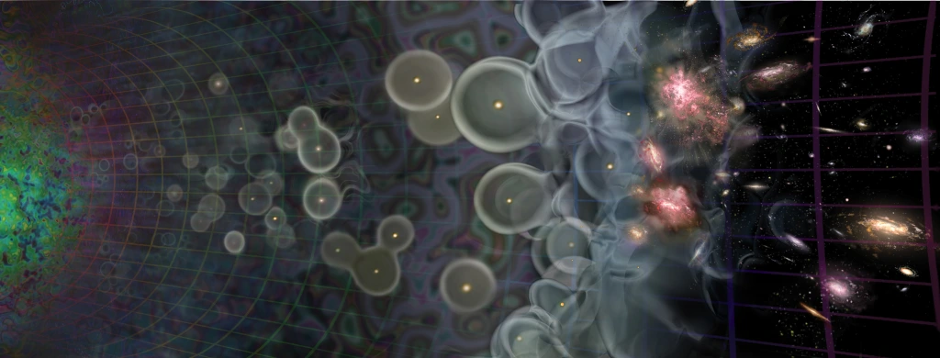
Artist’s conception of Cosmic Dawn and the Epoch of Reionisation. Image credit: Avi Loeb/Scientific American.
Where did it all begin: how and when did the first stars, galaxies, and black holes form?
The SKA will uniquely enable the measurement of a complete time sequence of images from the onset of Cosmic Dawn to the end of Reionisation, using the faint radio light coming directly from the hydrogen itself. The resulting movie of the Universe’s first 700 million years will answer a multitude of questions. When exactly did the first stars form? Were individual stars, large stellar clusters, or even early black holes the most important source of heating and ionisation of the Universe? How exactly did the process unfold? Was there a single progression from dark to light or were there multiple fits and starts, with different heating populations dominating at different times? This vital chapter in the history of the Universe was written long ago but is now waiting to be read.
Cosmology and Dark Energy
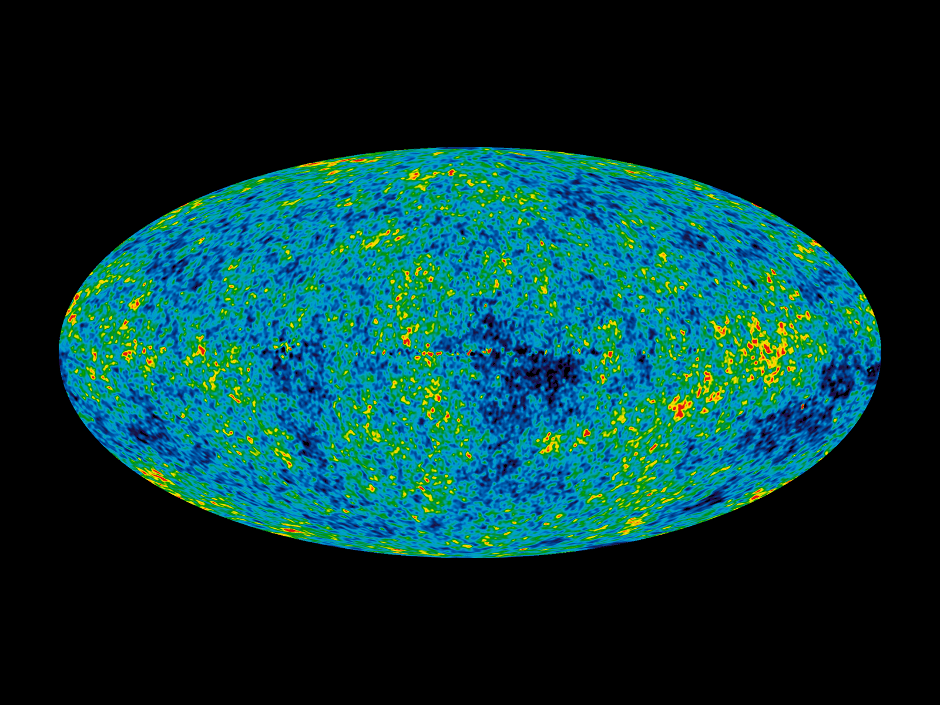
Cosmic microwave background radiation: Image credit: NASA/WMAP Science Team..
Can we uncover the mysterious nature of Dark Energy? How and why has it become the major player in our Universe?
One of the biggest surprises to emerge in the past decades was that normal matter, of which we are made and is described in the periodic table of the elements, is only a minor constituent of our Universe and is outweighed more than five to one by some form of invisible dark matter. This was followed by the discovery of the even larger contribution of dark energy. Since neither of these constituents were anticipated by current theories, we still desperately need to inform a more fundamental physical theory using observational constraints. The SKA will fundamentally advance our understanding of the mysterious dark components by measuring the equation of state of dark energy with percent-level precision; constraining possible deviations from general relativity on cosmological scales; and mapping the structure of the Universe on the largest accessible scales, thus constraining fundamental properties such as isotropy and homogeneity.
Forming Stars through Cosmic Time

Vigorous star formation in the colliding galaxy pair, Arp 299. Image credit: B. Saxton NRAO/AUI, NASA/ESA.
How and when were the first stars born? How has the rate of star formation changed over time, and why?
Although the basic pattern of growth and decline of star formation with time has been established, there are still many unanswered questions. We have evidence that the basic mode of star formation was fundamentally different in the early Universe, often occurring within intense concentrations of super star clusters (SSCs) that have few, if any, counterparts today. When and where did this mode first arise and how and why did it come to disappear? The SKA will play a key role in answering these questions since it is likely that such events are so deeply enshrouded by material that they can only be seen at radio frequencies that can penetrate the shroud. With the deepest SKA integrations, it will be possible for SSCs to be detected dating back to when the Universe was only 0.5 billion years old, and for resolved images of such structures to be made back to 1 billion years of age. The SKA will provide unbiased sampling of representative cosmic volumes, complementary to work begun by the Large Atacama Millimeter/submillimeter Array (ALMA) over smaller survey areas.
The Bursting Sky
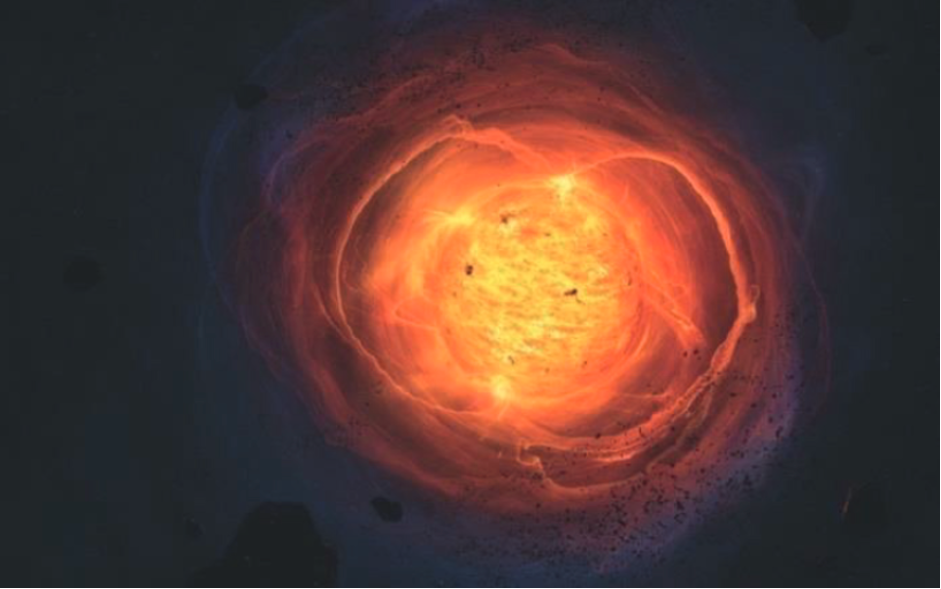
Artist’s impression of an exploding star. Image credits: digitalblasphemy.com
What are the counterparts of the fast and furious bursts of radio waves? What can they tell us about the constituents of the Universe?
SKA will enable us to associate thousands of individual fast radio bursts (FRBs) with the objects that host them, allowing us to map out the plasma content of the Universe. This will enable us to track how the Universe evolves with time in a way that was never previously possible. It will also help reveal the so-called “missing baryons”, determine the ionisation history of the Universe, and give us new and independent measures of the main drivers of cosmic expansion – the mass of the Universe and dark energy. The study of FRBs with the SKA will open a completely new window on the cosmos.
Galaxy Evolution
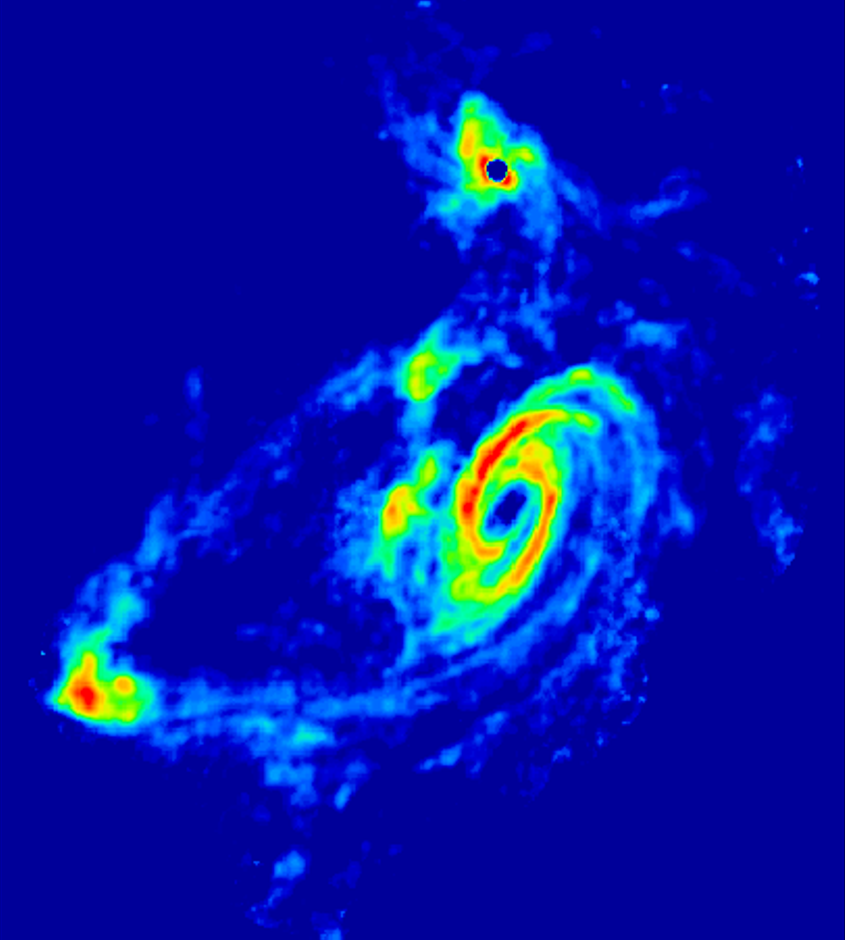
Neutral hydrogen image of the interacting M81 group of galaxies. Image credit: NRAO/AUI.
What is the life-cycle of a galaxy? Where do they come from, where do they go? What are the properties of the mysterious dark energy?
The SKA will, for the first time, allow galaxy evolution, as traced by the accumulation and utilisation of atomic hydrogen, to be observed throughout cosmic time. It will have the raw sensitivity to study the hydrogen concentrations that are associated with galaxies even in the distant, early Universe. SKA will be able to provide samples of 10 million galaxies spanning 8 billion years of evolution, which will greatly advance our understanding of the life-cycle of galaxies. With significant future upgrades to the survey speed, it will be possible to undertake the most complete galaxy census ever contemplated, encompassing one billion individual galaxies and covering 12.5 billion years of cosmic history. From this data, astronomers will be able to make the most precise determination yet conceived of the properties of dark energy.
Cosmic Magnetism
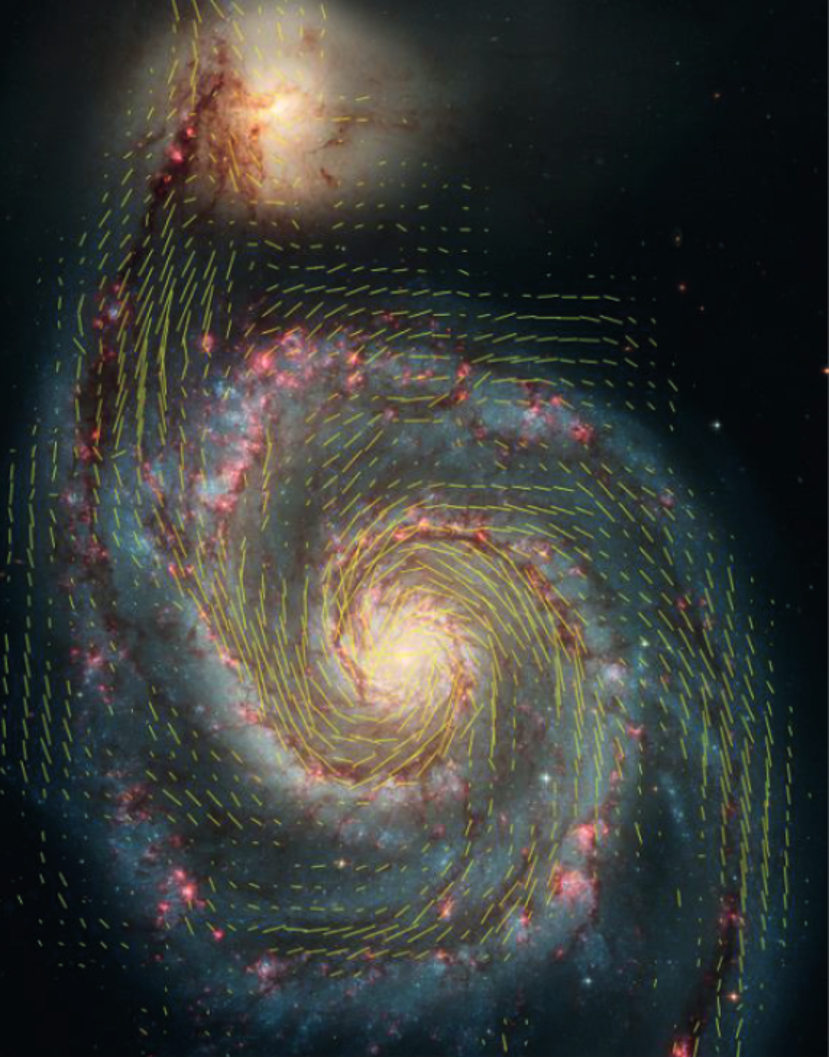
Magnetic field orientation in the spiral galaxy M51. Image credit: G. Heald, using data from Fletcher et al. (2011) and NASA, Hubble Heritage Team..
How did the Universe become magnetic? Where and when did magnetism originate and how has it spread?
Magnetic fields play an important role throughout the Universe on scales as small as centimetres and as large as millions of light-years, and magnetism may well play a key role in regulating a whole range of astronomical processes. SKA will be unique in giving scientists the capability to detect, study, and understand the nature of magnetic fields across the Universe. The aim of this research is to explain how and when magnetic fields arose and evolved to their current strength. SKA will enable the first three-dimensional magnetic map of the Universe to be created by measuring the individual magnetic components along the sightline towards extremely large samples of sources distributed in all directions on the sky, and by extending these measurements to sources at varying distances. de la distribución de campos magnéticos en el universo, midiendo las componentes magnéticas individuales a lo largo de nuestra línea de visión para muestras extremadamente amplias, repartidas por todo el cielo a distancias variables.
Challenging Einstein: Gravitational Waves
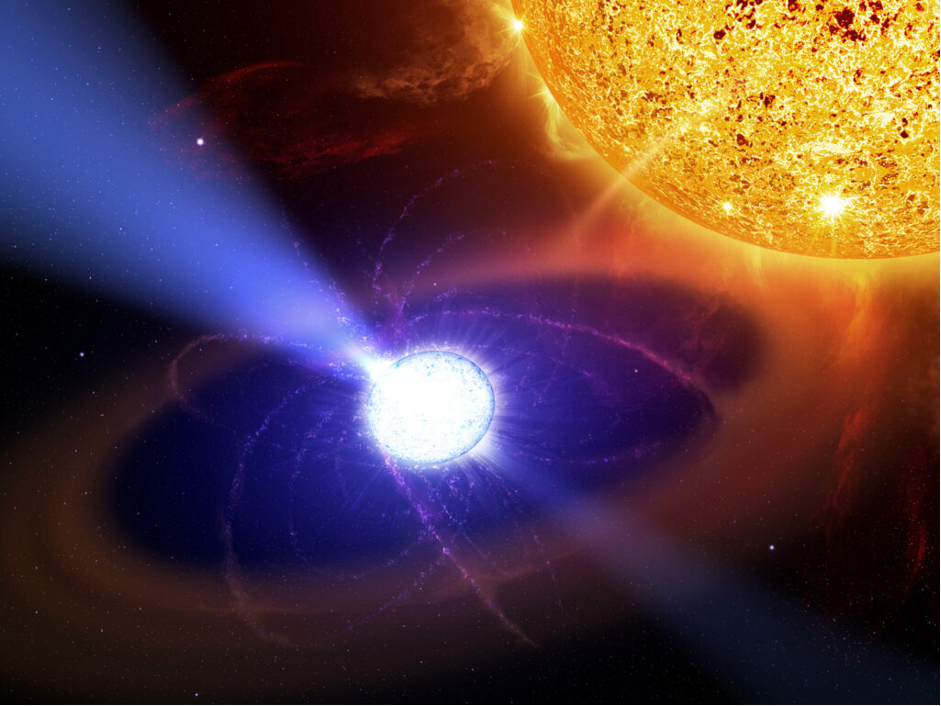
Artist’s conception of a pulsar and companion star. Image credit: Casey Reed/NASA.
Was Einstein right about gravity? Can we find and understand where gravitational waves come from?
The Laser Interferometer Gravitational-Wave Observatory (LIGO), in 2015, made the first direct detection of gravitational waves using detectors 4-km long. The SKA will use our entire galaxy as a detector to measure long-period gravitational waves (those of months to years duration) that are impossible to detect with Earth-based detectors. The period of the wave is a direct measure of the mass, making the SKA sensitive to the biggest black holes and largest structures in the Universe. The detection method involves using very rapidly spinning neutron stars with radio beams emanating from their poles, known as millisecond pulsars, as a system of high-precision clocks located throughout our galaxy. Each line connecting the SKA to a pulsar, which can be thousands of light-years in length, acts as a Milky Way scale LIGO-like detector. The passage of any long-period gravitational wave past the pulsars would result in a correlated fluctuation in the time measured by those clocks. The first goal will be to detect the long-period gravitational wave background due to sources from all directions and distances. With enhanced sensitivity and longer time sampling, it should be possible to identify individual sources of such waves and begin conducting gravitational wave astronomy for the first time, opening a new window on the Universe and giving us insight into how galaxies evolve and into the nature of gravity itself.
Cradle of Life
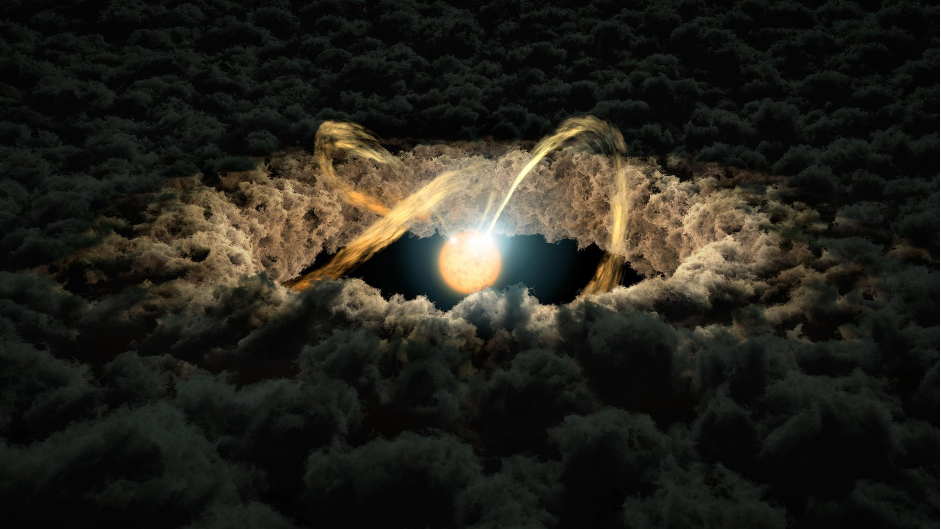
Artist’s conception of a protoplanetary disk. Image credit: NASA/JPL-Caltech.
How do you make a planet from space pebbles? Are we alone in the Universe?
The aim of this Science Driver is twofold:
1) To understand how the small pebbles in the disk surrounding young stars are able to stick together to form the boulders that ultimately coalesce into planets. With the SKA it will, uniquely, be possible to witness this phase of planet assembly by observing at exactly those radio wavelengths that are matched to the size of coalescing particles, from centimetres to metres; and with sufficient resolution to watch the assembly of planets in Earth-like orbits about their parent stars.
2) To detect the presence of technologically active civilisations elsewhere in our galaxy, should they exist. The great sensitivity of the SKA will make it possible, for the first time, to detect emissions from planets associated with nearby stars that are of a similar nature to those generated by human activity on Earth.

